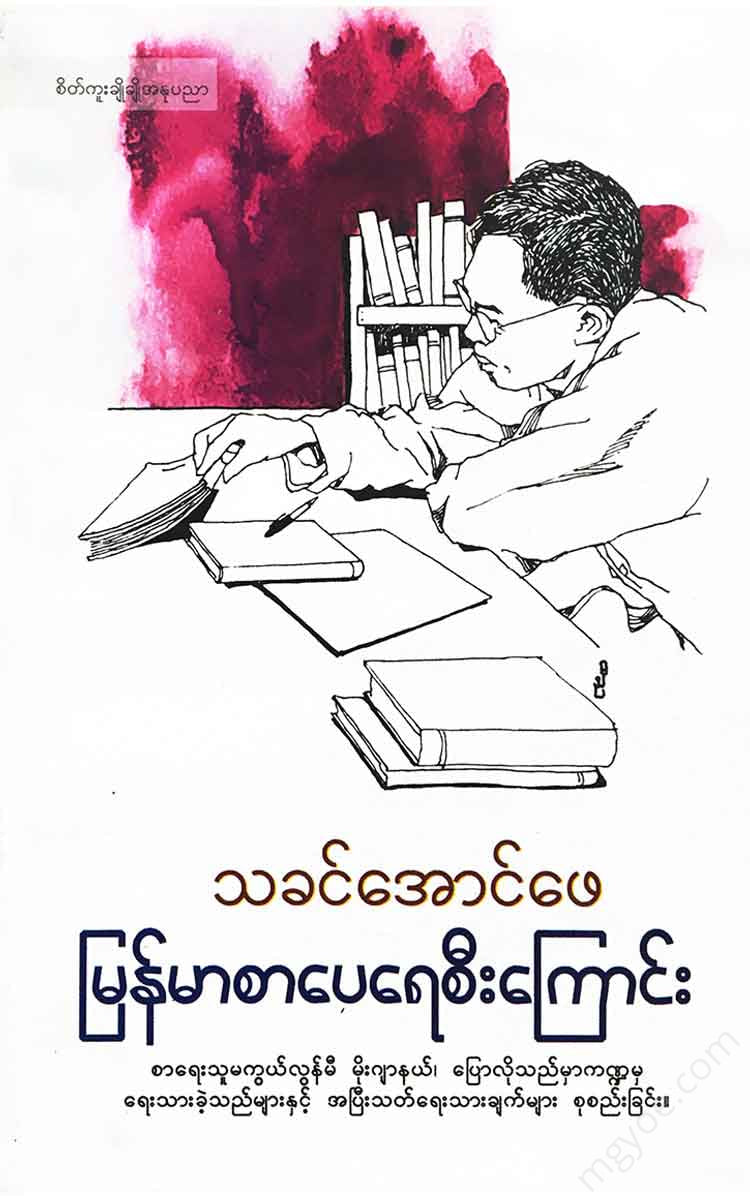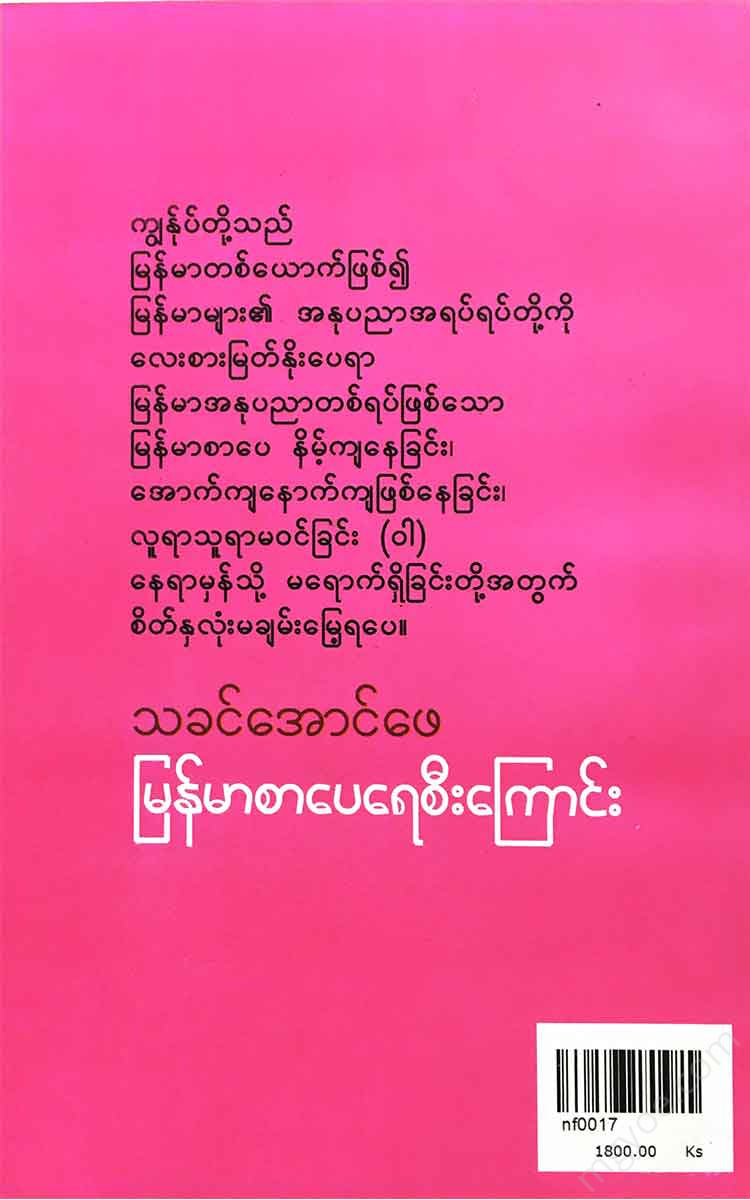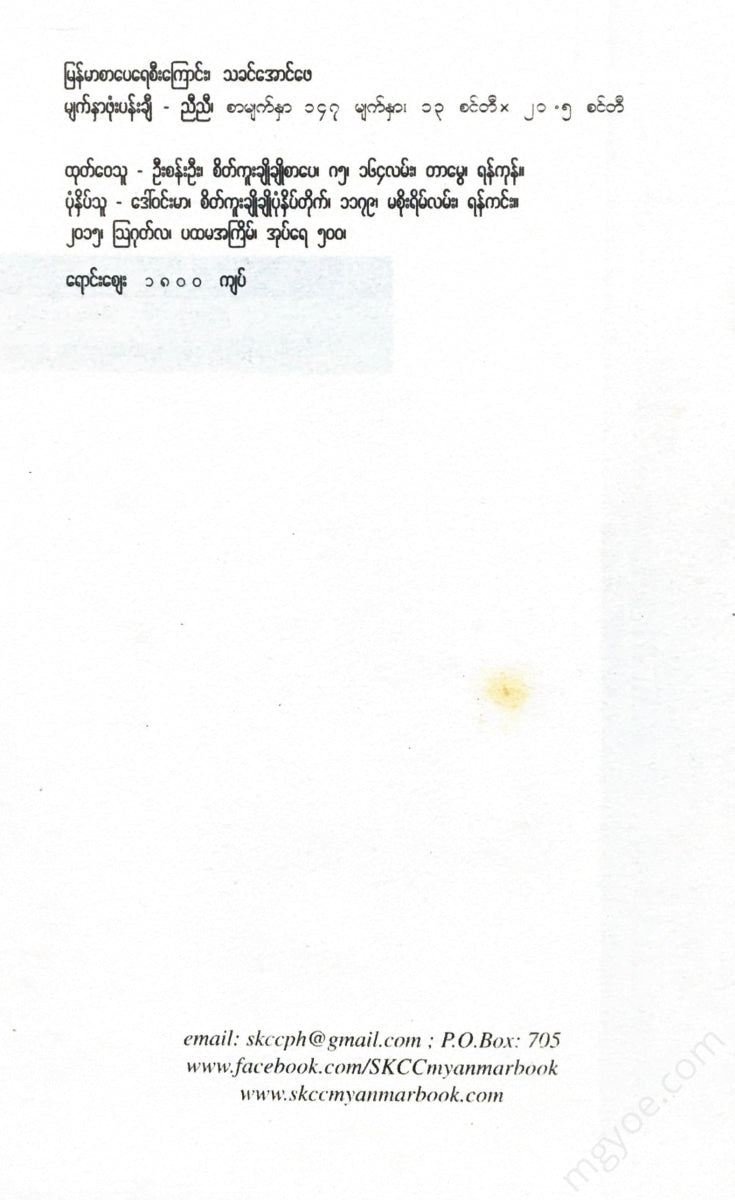စိတ်ကူးချိုချိုစာပေ
Thakin Aung Pe - Burmese literary currents
Thakin Aung Pe - Burmese literary currents
Couldn't load pickup availability
“If you look at the Burmese book lists, you will find many books of poetry excerpts. As for prose excerpts, I have yet to find any. Of the two, the Burmese seem to particularly like poetry. They study it in particular. As for prose, they do not seem to pay attention to studying and memorizing the use of words, the arrangement of sentences, and the structure of the story, except for the content of the story. This is a great defect in literature.”
The following passage is from the introduction to the Guide to Nibbana, written by the four-legged monk Kyathea, published by the Sasotan Kawi Eyeglasses Association in 1268.
The era that has passed (Wa) Innwa, Konbaung era can be called the era of poetry. They recorded certain topics in poetry. Poetry is a part of Burmese literature, but in those days, only those who could compose and write poetry could write.
The era of poetry was prosperous until people thought they were wise.
Today, Burmese literature is at the forefront of prose, and it can be called the prose era. Poetry and prose have fluctuated with the times since the Burmese language first appeared, like a drum and a fish. Prose writing came to the forefront during the Bagan period. The Bagan period was a time when Burmese literature was just beginning to develop, and every time it was spoken, it was as cute and lovely as a child who spoke in a babbling
Poetry came to the forefront during the Inwa period. Burmese poetry is beautiful because it is a time of socialization (or) youth, not youth. It is agile and agile. It is a land of abundance. It can be traced back to the Inwa period, up to the Konbaung period.
In the early days of Burma's independence, poetry and prose competed for the forefront. From around 1930, prose came to the forefront and has remained firmly at the forefront to this day.
Today, the Burmese language has matured considerably and has become stable as it has passed through various eras. It has become more refined and majestic.
Burmese is a language with a set of rules and regulations. It is not a language that you can write as you please. If you write a Burmese text, you must conform to the grammatical rules that govern Burmese.
When we were young, we learned Pali grammar in school as a translated grammar. In monasteries, we had to memorize Pali grammar and learn Burmese from the eight grammar books. English students had to learn English grammar.
The great writers who are said to be proficient in Burmese writing today are monks who are proficient in Pali grammar, such as Atwa Akhara Thanyadaw.
The saying "Saddhatmata, satmata" is a slogan from the monasteries. This slogan is also a true statement that cannot be repeated without a single word.
When learning grammar, we learn about tenses, tenses, tenses, verbs, adverbs... nouns, pronouns, prepositions, adjectives, singular, plural, sentences, etc. Those who know grammar can write Burmese fluently.
If you write a Burmese text, it will be easy to read aloud. It will not be stammering. If you read it aloud and look at it with your eyes, it will be clear. Your eyes will not be confused. A clear and easy-to-read text will have a clear meaning at the end of every sentence. You don't have to think about how it will be, what it means. You will know what it means right away.
If you want to learn Burmese writing, teachers recommend reading the Ten Chapters of Sayadaw U Thuba Tha and the writings of Sayadaw Kyaithae Layt.
In the great Vidura Jataka of Sayadaw U Thubhasa
When Vidura Sukhamin had gone, the five hundred brides, dressed in the attire of gods and goddesses, performed beautiful and sublime dances, songs, and musical instruments near that temple, and enchanted with their delightful sensual pleasures.
...Thus, Vidura Sukhamen, who was accustomed to observing the Dhamma and thinking only of his own interests, delighted Punnaka with special sensual pleasures, then entered the apartment of his great wife, named Anawja, and said to her, "Call your wife, who is like the pure gold of the king of Zamburaja, and whose body is anointed with the fragrance of the finest sandalwood, and who, following her husband's wishes, is a great mistress who is not angry, does not quarrel, and knows how to behave with her husband. My children are my children,
The writings of Sayadaw U Sobhatha, translated from Pali into Burmese, are so thorough and well-written that nothing can be added or subtracted. When read aloud, Sayadaw's Burmese writing is fluent. (Wa) It is easy to read fluently and easily. Even if you read it aloud, it is clear to the eye.
Sayadaw's Burmese language is short when it should be short. It is long when it should be long. In Burmese, the construction of sentences is not about length or brevity. What is important is the ability to write clearly and to organize them so that they are pleasing to the eye.
The monk was so careful in writing Burmese that he did not write the word "wet-ning" to avoid having two words in a sentence, which is a common practice in our day and age.
The great literary scholar who could write the praise of the Himalayas in the Vaisantara Jataka of the Sayadaw as if he were himself in the forest while reading it.
Look at the writings of the Four-Four-Sixth-Century Monk.
In the Guide to Nibbana
... Thus, the monks, who have spoken evil words to the Sangha, and have spoken evil words to them, such as "Ali Dussil, Abiyya, U Pyi", This is why, in this age, we are faced with five kinds of difficulties in the Dhamma, and many noble people who believe in the teachings of the beloved Buddha, who, with their faith, believe in the five kinds of things, will not go to hell if they die, and who are not disrespectful to the Buddha, disrespectful to the Dhamma, disrespectful to the Sangha, disrespectful to the Dhamma, disrespectful to the Sangha, disrespectful to the Dhamma by false teachings, disrespectful to the Dhamma One should not touch, touch, or touch anything, be careful, and avoid it.
The monk's writing style is clear and concise, using short sentences. The monk himself states in the beginning of the book that this guide to Nibbana was written on the 2nd day of the full moon of Thadingyut in 1228.
This means that the Nirvana Guidebook was written during the reign of King Mindon.
Read the monk's sermon.
The story of Nandi Meita is this: Among those ten, a minister named Mitta, who was the general of the Elara king, gave a large village near the mountain called Citta in his territory to his sister, and she made her home there. The son of that sister was endowed with great strength, and she took the name of her uncle Mitta, the general, and named him Mitta. The boy was so good at running around that even at the age of seven or eight, his parents followed him and gave him a big bag on his back.
He tied him up with a rope. When he reached his house and crossed the threshold, he broke the rope and ran away. That is why he was called Nandi Meita. When that young man grew up, he could carry the weight of ten elephants, and after coming to the city, he lived with his uncle. He also respected the Dhamma. Then, near the city of Anuradhapura, the Kukula, who had destroyed the pagodas and other places without offering sacrifices, suddenly turned around and trampled on one leg with his foot and held the other leg with his hand, and split it like bamboo.
It is not wrong to say that we Burmese people keep the Mahavin, including the nine Vins, in the front room of our homes and worship and enjoy it because of the excellent translation and writing of the Sayadaw.
Sayadaw's Jinatha Pakathani is a book that every Burmese Buddhist has read.
Every house has a copy of the book. Every Burmese person knows the size and quality of the book, and the name of the book is Zinatha.
The fact that Burmese Buddhists revere, offer offerings to, and worship Gautama Buddha to such an extent is probably due to the great abbot's Zinatha Pakathani, more than half of it.
Before the publication of the Jinatha Pakathani, there was no such thing as a Myanmar Buddhist Book (Buddha's Life), or a large collection of books. The Burmese people know and respect the Buddha's life because of the Jinatha Pakathani. Even today, there are Buddhists who are still printing and selling the Jinatha Pakathani.
Aung is still there. The reason is that the writings of the monk are still modern to this day.
We write that the Buddha is a great sage. The Buddha himself does not boast about himself, but rather writes that he is great and great. It is amazing that the Buddha boldly boasted that he was a great sage among the great sages and sages of his time. In the conclusion of the Maha Vinaya.
... The great four-fold, the The knowledge of the Vedas, which is the ability to study the Vedas, the
And so on, I and only I, the great teacher who boasted that I am the teacher.
The disciple of the great monk, the great monk, Thakin Tshoung, used to praise his true teacher, the great monk, the great monk, at every opportunity. In fact, he was a great scholar with endless reasons to praise him.
Our monk, the original monk, was very fond of reading. He never took his eyes off books. All kinds of books were scattered around his place of residence. He was a student of the late monk, and he had all the treatises of the late monk, and he said, "If you want good content in Burmese, look at the Mangye and the late monk's books."
Kyaw Zaw calls the Mangye Sayadawgyi Makara Lopa, the Sayadawgyi. In Burmese, he is a scholar who knows nothing and is not capable of anything.
The writings of the Mangye Sayadaw and the Maha Suttakairi, also known as the Magha Veda Lanka, must also be mentioned. A true Burmese scholar must have had some kind of love affair with Magha Deva. The battle between the Sayadaw and the Puthien U Paduma over the killing and non-killing of Pathein was very famous in the literary world. The non-killing Pathein written in the past were changed to the killing and non-killing of Pathein due to the Sayadaw’s reasoning.
The first monk, Okpho Sayadaw, also believed that Pu Thein was the only one who was truly a monk. The great monk Thein also showed with many evidences that the only one who was truly a monk was the one who was truly a monk.
The Sayadaw, who rose to prominence in the war between Nath and Math, is considered to be the greatest of all the worlds.
Yes





